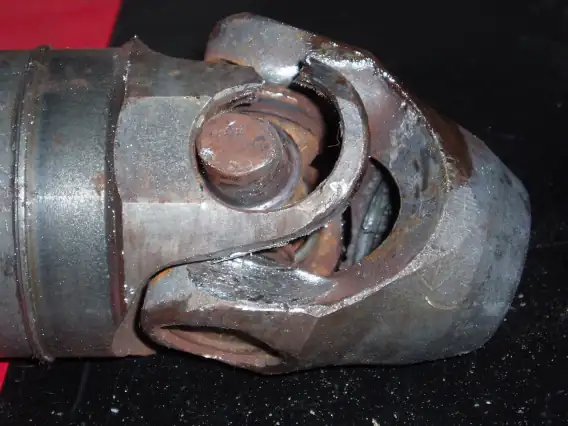Preventing Downtime: Best Practices for Maintaining Universal Joints in Mining Equipment
Table of Contents
In the mining industry, equipment reliability is paramount. A significant cause of unexpected downtime stems from worn-out or damaged universal joints (U-joints). These critical components play a key role in power transmission between shafts and machinery, allowing for flexible movement while transferring torque. If not properly maintained, U-joints can fail, leading to equipment breakdowns, costly repairs, and lost productivity.
This blog post will provide a comprehensive guide on best practices to maintain U-joints in mining equipment. We’ll explore key maintenance tips, signs of wear, and how proactive care can help extend the lifespan of these essential components.
Why Are Universal Joints Crucial in Mining Equipment?
Universal joints are used in many types of heavy mining machinery, such as loaders, haul trucks, conveyors, and drilling equipment. They allow for power to be transmitted between misaligned shafts, which is essential in equipment that operates under rugged conditions, where flexibility is required.
In the mining environment, machines are subjected to extreme vibrations, heavy loads, and varying speeds. Universal joints enable these machines to function smoothly and efficiently, even under such harsh conditions. However, due to these demanding factors, U-joints are prone to wear and tear over time, which is why regular maintenance is critical.
Signs of Worn or Failing Universal Joints
Before diving into maintenance tips, it’s important to understand the signs of wear that indicate a U-joint may be nearing failure. Early detection can help prevent major breakdowns and equipment downtime.
- Vibration and Noise: One of the first signs of a failing U-joint is unusual vibrations or clunking noises during operation. This may occur as the bearing caps or cross pieces wear out and no longer provide a smooth rotational movement.
- Increased Play or Looseness: If you notice increased play in the driveshaft or if the U-joint feels loose when manually rotated, it’s a sign that wear has occurred. This can be especially dangerous if left unchecked, as it can lead to catastrophic failure.
- Uneven Wear on Machinery: When U-joints are worn out, they can cause misalignment, which leads to uneven wear on other components such as bearings, seals, and shafts.
- Leaking Grease or Contamination: U-joints typically require lubrication, and any signs of grease leakage, contamination, or buildup of debris indicate that the joint is not properly sealed, leading to faster wear.
- Rust or Corrosion: Over time, exposure to moisture, dirt, and chemicals can cause rust or corrosion on U-joints. This is especially true in mining environments where machines often encounter abrasive materials. Rust can weaken the joint, making it more susceptible to failure.
Best Practices for Maintaining Universal Joints
Now that we’ve covered the signs of wear, let’s focus on how to maintain U-joints to prevent breakdowns.
1. Regular Inspections and Visual Checks
Performing routine inspections on all U-joints is one of the most effective ways to prevent unexpected failures. During these inspections, check for:
- Unusual noise or vibrations during machine operation
- Any visual signs of wear, corrosion, or loose components
- Leaks or signs of grease contamination
Make sure that inspections are documented, and any concerning signs are addressed immediately. An overlooked small issue can quickly escalate into a bigger problem.
2. Lubrication: The Lifeblood of U-Joints
Lubrication is critical for extending the lifespan of U-joints. It reduces friction and protects the joint from contaminants. Always ensure that U-joints are properly lubricated using high-quality grease suited for extreme operating conditions, such as heavy mining.
- Frequency of Lubrication: Depending on the operating conditions and manufacturer recommendations, U-joints should be lubricated at regular intervals. For equipment in harsh environments like mining, this may be required more frequently than in less severe conditions.
- Quality of Grease: Ensure you’re using grease that’s compatible with the equipment and operating conditions. For example, extreme pressure (EP) greases are typically recommended for heavy-duty applications.
- Grease Ports: Ensure that U-joints with grease fittings are regularly serviced, as these fittings allow for fresh lubrication to reach the joint bearings.
3. Maintaining Proper Alignment
Misalignment of the shafts connected by U-joints can place excessive stress on the joint, accelerating wear. Regularly check the alignment of driveshafts and other components to ensure they are properly positioned.
Misalignment often leads to uneven wear on the U-joint and connected parts, which can be easily corrected with early detection during maintenance checks.
4. Replace Worn Seals
The seals around U-joints are crucial for keeping dirt, debris, and moisture out of the joint. Over time, these seals can degrade or become damaged. Replacing worn seals promptly helps to maintain the integrity of the joint and ensures that the grease inside remains uncontaminated.
5. Consider Upgrading to Heavy-Duty U-Joints
For machinery operating under particularly heavy loads or extreme conditions, consider upgrading to heavy-duty U-joints designed for these demanding applications. These U-joints typically have reinforced components that provide greater durability and are better suited for high-impact environments.
6. Replace U-Joints at Recommended Intervals
Even with the best maintenance practices, U-joints will eventually wear out. Make sure you follow the manufacturer’s recommended replacement intervals to avoid unexpected failures. Keeping spare U-joints on hand is a proactive way to minimize downtime when a replacement is necessary.
Case Studies: U-Joint Failures in Mining Equipment
To understand the importance of proper U-joint maintenance, let’s look at two case studies where neglecting maintenance led to costly consequences.
Case Study 1: Loader Breakdown Due to U-Joint Failure
A mining company experienced repeated breakdowns with one of its loaders. Upon investigation, it was found that the U-joint was the culprit. The joint had not been lubricated properly, leading to increased friction, wear, and eventual failure. The downtime resulted in significant delays and repair costs, not to mention lost productivity.
Case Study 2: Haul Truck U-Joint Corrosion
In another case, a haul truck operating in a particularly wet and abrasive environment suffered from U-joint corrosion. Routine inspections had not been performed, and the U-joint eventually failed during a critical haul. The replacement process was time-consuming, and the lack of spare parts on-site caused further delays.
The Benefits of Proper U-Joint Maintenance
Proactive maintenance of U-joints offers several key benefits for mining operations:
- Reduced Downtime: By regularly inspecting and maintaining U-joints, you can catch issues early and replace components before they lead to costly breakdowns.
- Extended Equipment Lifespan: Properly maintained U-joints contribute to the overall longevity of mining machinery, reducing the need for frequent replacements.
- Lower Repair Costs: Addressing small issues early on, such as lubrication or seal replacements, can prevent more expensive repairs or even full U-joint failures.
- Improved Safety: Properly functioning U-joints ensure that equipment operates safely and efficiently, reducing the risk of accidents caused by mechanical failure.
The Future of U-Joint Maintenance in Mining
As technology advances, new methods for monitoring U-joints and other power transmission components are emerging. For instance, predictive maintenance systems using sensors and IoT technology are becoming more prevalent in the mining industry. These systems can monitor the condition of U-joints in real-time and provide alerts when maintenance is required.
By incorporating predictive maintenance into your equipment management strategy, you can reduce the likelihood of unexpected failures and ensure that your machinery is always operating at peak performance.
Preventing Downtime: Best Practices for Maintaining Universal Joints in Mining Equipment
Conclusion: Maintain Your U-Joints and Avoid Costly Downtime
Universal joints are a small but vital component in mining machinery. Regular maintenance—inspections, lubrication, alignment checks, and timely replacements—can prevent the headaches of unexpected breakdowns and keep your operation running smoothly.
If you’re dealing with worn or broken U-joints and need replacements, visit Twin Spring Coupling’s website. We offer a wide range of high-quality U-joints and other couplings designed for the mining industry. Don’t let a simple component bring your operation to a halt—ensure your machinery stays in top shape with our OEM and aftermarket solutions.
Call to Action: Browse our catalog of universal joints and other couplings today. Our team is here to help you find the right part for your equipment, and with our expert knowledge, you can ensure your machinery remains operational and efficient. Visit Twin Spring Coupling now for more information!

